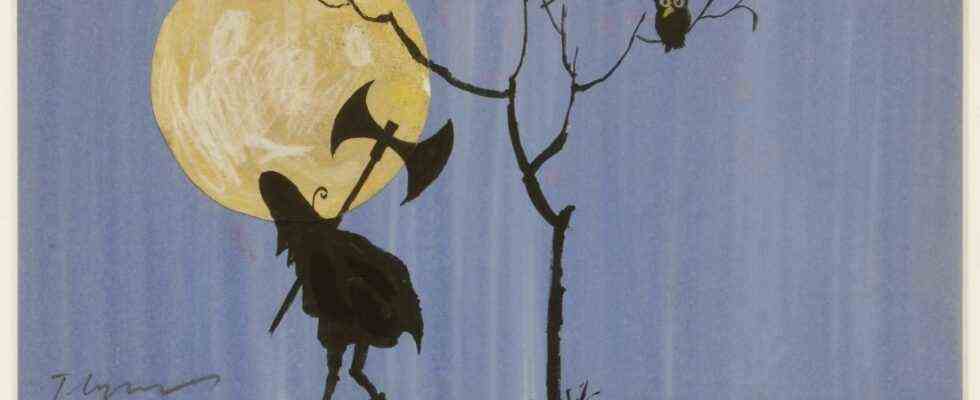Tomi Ungerer once said it was fantastic when death was nothing, then one could fill it with a new spirit. Now you can be sure that if he was right, his mind sits behind this last gate and thinks up great things, as manically as Ungerer has worked his whole long life on his picture of the world on paper. For the major retrospective that will open on his 90th birthday on November 28th in the Falckenberg Collection of the Deichtorhallen in Hamburg-Harburg, the other side of his work will have to be foregone. Almost three years ago Tomi Ungerer died in his house on the southern tip of Ireland, smiling and with a book in hand. Death, which has accompanied the French draftsman since childhood, as a commenting, often malicious accomplice, remains omnipresent as a deceived witness.
The personified negation of the life that Ungerer loved so much can be seen everywhere in this large exhibition, which shows pictures from 80 years. The skeleton is already an important player in the first processing of the Nazi invasion and the war in Colmar, which the Alsatian preschooler drew. In his later satires on the decadence of New York society, the contortions in tuxedo and evening dress are a dance of death with a thin layer of skin and luxury. And just a few days before his death, he created one last large collage: a dark chorus from Roger Federers starts a collective scream of fear.
Tomi Ungerer’s poster against the Vietnam War, 1967, can be seen in the exhibition of the Falckenberg Collection.
(Photo: Diogenes Verlag AG, Zurich / Tomi Ungerer Estate)
The fact that Tomi Ungerer is primarily famous as a children’s book author who has invented and drawn over 140 stories does not contradict the permanent presence of the tailor in his art. He was both successful and hostile throughout his career precisely because he did not ban death from his stories for children, any more than eroticism, the second permanent guest in his life theater. Ungerer’s most famous stories are about cannibals (“Zeraldas Riese”, 1967), gloomy criminals (“The Three Robbers”, 1961) or a teddy bear who lived through the time of the Third Reich with deportation and war (“Otto”, 1999).
Ungerer’s favorite song was “The thoughts are free”, and this is also the name of this extensive exhibition, which celebrates his incorruptible will to informality: “It’s all about Freedom.” It evokes biographical sections on three floors, starting with the impressive children’s drawings and unknown works from the fifties that were found in a box in his Strasbourg apartment and already show the changeable genius that adapts the aesthetics of his time with a quick pen. But his unswerving anger at the injustice, obsession with power and the destructive of man finds the first examples of caustic satire, for example in the caricature of a clergyman who gropes two boys as his “sheep”.
The largest section of this posthumous journey of discovery with various unpublished series is devoted to the time he started his career in New York. A poor devil who arrived in the United States sick in 1956, the versatile self-taught person became the art director’s prodigy and proud owner of a Cadillac and a mansion in the Hamptons. Campaigns for the new Yorker and Village Voice, Caricatures of the rich on Long Island beach or his famous poster motifs against the Vietnam War, apartheid in the USA or police violence show Ungerer’s diversified attitude, who created a symbol for all aspects of life.
Tomi Ungerer, born in Strasbourg in 1931, lived between Alsace and Ireland, where he died on February 9, 2019 at the age of 87.
(Photo: Gaetan Bally / picture alliance / dpa)
In Hamburg in particular, Ungerer’s erotic work is a compulsory chapter. After all, in 1985 he lived for a few months with St. Pauli’s most famous whore Domenica on Herbertstraße to describe the reality of sadomasochistic sex work in words and pictures – what was then called “The Guardian Angels Hell “(1986) was published by his in-house publisher Diogenes. Fifteen years earlier, his series “Fornicon” (1970), which he called satire, had led to a scandal in the USA that prompted him to leave New York in 1971. Using Barbie dolls as a model, he had drawn scenes of mechanical masturbation that could be understood as the love of fetishistic sex. American parents don’t forgive the child prodigy for this.
Even after this comprehensive exhibition, a lot of “new things” can be expected from the deceased, because according to his daughter Aria Ungerer, the development of his overflowing estate will take another ten years. Various books are currently being reissued, including English editions of “Babylon”, “America” and “Tomi Ungerer’s Treasury” with his eight best children’s books, as well as a German version of “Frances Face Maker”, a book that Ungerer wrote in 1965 with William Cole had made. Two of his children’s books are made into a film: “Flix” as an animated television series and his teddy bear perspective on the Third Reich, “Otto”, as a feature film. And the Tomi Ungerer Museum in Strasbourg is preparing a large exhibition on “Metamorphoses” in its work for 2022. Tomi Ungerer’s fantastic afterlife is guaranteed.

